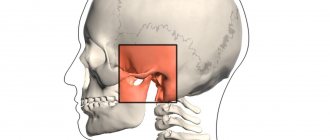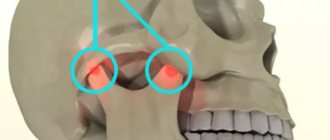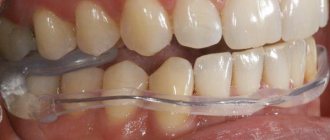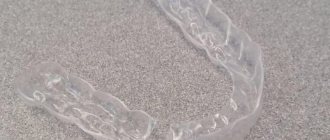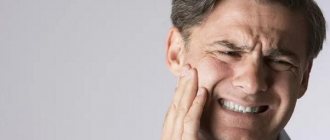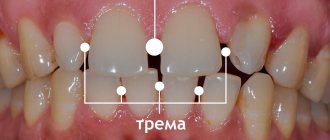2981
Splinting has always remained the main method of eliminating dysfunction of the TMJ (temporomandibular joint).
But, for some time now, most violations began to be corrected with specially designed joint splints.
The studies revealed that the defects respond well to treatment with the TMJ splint from MRC.
General information and purpose
The TMJ splint is a rigid, removable, thermo-modeling device that is worn like a mouthguard on one of the jaws.
The device is intended for intraoral use in adult patients. The design and construction were developed using a computer system. Supplied with preset parameters.
The splint is of great importance for doctors, as it allows them to begin correcting functional disorders already during the initial appointment.
Occlusive therapy for TMJ dysfunction
After diagnosis, the patient is scheduled for an appointment with the orthodontist to determine the central relationship of the jaws (“true” position of the lower jaw, the position in which your joint and chewing muscles will be most comfortable).
In order to more accurately establish and fix this position, an occlusal splint (splint) will be individually made for the patient from a special plastic, which is erased as it is worn. The splint must be worn constantly (sleeping, talking, eating in it if possible) - this is the meaning of occlusion therapy, which will help the joint and masticatory muscles rebuild into the most comfortable functional state.
Cleaning and caring for the splint is very simple - after eating (as well as while brushing your teeth), brush with a soft brush with toothpaste or soap.
Design Features
Structurally, this device is a two-layer apparatus, the outer thermoplastic shell of which quickly softens when lowered into hot water.
Fitting onto the jaw arch, it sets it in the correct position due to the constant shape of its base.
The splint has a rigid wing-shaped base , the dimensions of which are considered ideal for decompression of the temporal joint. There are 2 models of the device available: with a base thickness of 4 mm or 2 mm.
Each wing of the device extends forward and backward beyond the molars by 2 mm and 2.5 mm, respectively, which provides effective support for the lateral dental units.
The stopper provided in the design restrains lateral movements, and a special tongue guard eliminates the possibility of the tongue sinking or swallowing.
Purpose of the T4k pre-orthodontic blue and pink trainer and its principle of operation.
Read here what problems can be solved with the help of orthodontic trainers for adults.
At this address https://www.vash-dentist.ru/ortodontiya/kapyi/ot-hrapa-alternativa-hirurgicheskomu-vmeshatelstvu.html we’ll talk about the effectiveness of an anti-snoring mouth guard and how it works.
Indications and restrictions
The role of the temporomandibular joint in performing articulatory and chewing functions is significant. Hundreds of thousands of movements are performed per day when a person eats, drinks, talks, facial movements, breathes and cleanses the oral cavity. Helps to fully carry out the closing and opening movements of the lower jaw, and its movement to the sides.
If there are disturbances in the dental system, the joint begins to function incorrectly, pain, dizziness, discomfort, swelling, and hearing loss appear.
The reasons leading to dysfunction are:
- malocclusion;
- an operation resulting in disruption of the TMJ function;
- any damage to the jaw;
- infection;
- stressful state;
- breathing through the mouth;
- congenital anatomical anomaly;
- pathological abrasion of teeth;
- excessive physical activity;
- abuse of solid foods.
Research shows that 35% of all patients are diagnosed with temporomandibular joint dysfunction. The first thing doctors prescribe is wearing a joint splint.
TMJ modification is recommended for patients suffering from joint dysfunction if they have:
- deviation from the normal position of the articular disc;
- clicking sound when moving the joint;
- difficulty opening the mouth.
Treatment of joint dysfunction using any modification of splints cannot be carried out if the patient’s medical history reveals:
- diseases of the central nervous system;
- neoplasms in the oral cavity;
- acute form of neurological condition.
Joint splint TMJ
One of the most actively used joints in the human body is the paired bone joint that connects the mandibular region with the cranial base. Damage to the cartilage tissue covering the articular surface, caused by bruxism or defects in the development of occlusion, requires orthodontic treatment. Among the devices used to restore the natural anatomical structure of the joint, the TMJ dental trainer is prescribed for restoration to patients of all age groups.
Operating principle, wearing order
Thanks to the patented wing-shaped shape, the base of the splint creates the effects of gradual decompression and muscle relaxation.
Having the parameters of an ideal jaw arch, the device fixes the relative position of both jaws according to class I, while correcting the position of the mandibular arch and lateral parafunctionality.
The device does not cause any particular discomfort when worn and quickly adapts to the individual characteristics of the patient’s dental system. There is also no need to take an impression, and it must be further processed and adjusted before putting it on for the first time. Produced in universal sizes.
Placement (fitting) of the tire is quick (about 5 minutes) without any particular difficulties. At the end of the procedure, the person receives a comfortable individual splint that relieves joint problems.
In addition, the TMJ modification fits well even with partial edentia (the absence of a certain number of dental elements).
The entire fitting process takes place in the following sequence:
- Device for 2 min. placed in hot water.
- After this time, which is sufficient to soften the outer thermoplastic shell, it is removed and allowed to cool for about 10 seconds.
- Strengthens in physiological occlusion on the dentition. Due to the tight fit and low profile, ideal tire adhesion is ensured.
- The patient is offered for 20 seconds. Close your teeth tightly and breathe through your nose, creating a vacuum in your mouth.
- Afterwards, the device is removed and lowered into cold water to cool completely.
If necessary, the process of fitting the same device can be repeated several more times.
The device is designed for daytime wear : it should be worn while doing homework, reading, working at the computer, or watching TV. Does not interfere with a person’s ability to speak freely, does not distort speech, and does not cause discomfort or pain.
The patient will feel the first changes in the condition after the first couple of days of wearing it. Depending on the severity of TMJ dysfunction, the course of correction with a TMJ splint lasts from a month to six months.
Important! Ideally, a hard modification should be used in combination with a soft one (TMJ), designed for night wear.
In the first days of treatment, the sensitivity of the incisors may increase and mild pain may appear, which is considered a normal condition. In this case, doctors advise reducing the duration of wearing by 3-4 hours, and after normalization of the condition, bringing the prescribed treatment time to normal.
If, at the end of the course, the patient continues to complain of pain even in the absence of obvious symptoms of TMJ dysfunction (clicking joint, difficulty opening the mouth), the dentist decides to refer the patient to a neurologist to prescribe drug therapy.
What OrthoSnap aligners look like on teeth and when their use is justified.
In this publication you will find a detailed description of Star Smile aligners and the price of the product.
Here is all the most important information about T4A trainers.
What happens if TMJ dysfunction is not treated?
If the dysfunction is not treated, the compensatory capabilities of the body may sooner or later be exhausted, the symptoms will worsen, the pathology will begin to progress, causing greater discomfort (sometimes for several years), thereby affecting the deterioration of the function of the dental system.
In order to try to prevent this and carry out treatment taking into account the individual characteristics of the structure and functioning of the temporomandibular joints, patients are usually offered the following approach.
Expected effect
Important! Symptoms of TMJ dysfunction with timely treatment with the TMJ splint decrease or disappear completely without the use of additional procedures.
This device already helps in the first days of wearing:
- reduce acute pain and other symptoms;
- relieve the load from the joint;
- limit bruxism;
- eliminate parafunctional habits (for example, tongue swallowing);
- correct occlusion;
- eliminate reverse swallowing;
- cure mouth breathing;
- reduce the load on the dentition during athletic sports.
In addition to the therapeutic effect, the joint splint allows you to diagnose conditions that cause pain in the head and neck.
Treatment method for TMJ dysfunction
1. Diagnosis of TMJ dysfunction.
- When diagnosing a joint in the clinic, a series of measurements and tests are carried out, all sensations in the joint area are recorded (discomfort, clicks, pain, deviation of the jaw when opening and closing), the difference in sensations in the right and left joint.
- The orthodontist also takes impressions of the jaws and takes photographs of the face and intraoral photographs, and also performs three-dimensional computed tomography of the face (3D CT); if necessary, the doctor can give a referral for an additional study - magnetic resonance imaging of the TMJ (MRI).
- Often, the orthodontist, in addition to manual functional analysis, conducts a visual assessment of: posture, symmetry of the shoulder girdle, shoulder blades, hip bone structures, etc., performs the necessary tests and photographs. Based on the results, it is possible to schedule a consultation with an osteopath or chiropractor to jointly manage the patient. Related specialists (orthopedist, surgeon, periodontist) can also be involved in drawing up a treatment plan.
What exercises are prescribed to patients to normalize the work and relax the masticatory muscles?
Exercise No. 1
Draw a vertical line on the mirror with a marker, stand opposite so that the line divides your face into the right and left halves, place your fingers on the area of the articular heads, lift your tongue up and back, open and close your mouth along the line (it may not work right away), 2-3 times /day 30 repetitions. There is no need to open your mouth wide (a comfortable width), the main thing is symmetrically (so that the jaw does not “move” in any direction). If there is a click, open until it clicks.
Exercise No. 2 (cycle)
Do it whenever possible, for example, in front of the TV, at the computer, or in a traffic jam while driving. Open and close your mouth without closing your teeth for 30 seconds, then alternately reach your right and left cheeks with your tongue for 30 seconds. Open - close your mouth again, then for 30 seconds move your tongue in a circle inside the vestibule (behind the lips), first in one direction, then in the other direction (clockwise - counterclockwise), open again - close your mouth, etc.. For this a half-hour cycle, the teeth should not touch, the lips should be closed. If you want to close your mouth or swallow, place your tongue between your teeth. Repeat the cycle for 20-30 minutes 2-3 times/day
Price
It is difficult to name the exact cost of the device. This figure, depending on the place of purchase, ranges from 3.5 thousand rubles. up to 4.5 thousand rubles
It is also important to take into account the fact that you will additionally have to pay for a consultation and x-ray, which is about another 1 thousand rubles.
Several other factors influence the cost of treatment:
- doctor's qualifications;
- status of the medical institution;
- the region of its location;
- pricing policy.
The exact cost of eliminating disorders in the TMJ should be found in the dental clinic where treatment is planned..
The video provides additional information on the topic of the article.
Installation of a brace system for a patient with TMJ dysfunction
Installation of a brace system on the upper jaw is carried out on average after 3 months of occlusion therapy. The splint is adjusted once every 1-2 weeks, or at the discretion of the doctor, until the main complaints from the TMJ are eliminated (in parallel with the alignment of the teeth in the upper jaw), then a brace system is installed on the lower jaw with partial reduction (grinding) of the interfering parts of the occlusal tires, or complete removal. Here the patient needs to be patient - the process may take several months.
At the same time, the new position of the lower jaw is monitored: repeated manual functional analysis, photometry, bite registration is possible, computed tomography of the face during treatment, continuation of orthodontic treatment with a brace system.
Upon completion of orthodontic treatment, final monitoring of the position of the lower jaw follows (manual functional analysis, photometry, bite registration, 3D CT scan of the face upon completion (after) treatment).
Joint splint with braces
Reviews
Modification of the TMJ joint splint quickly corrects many temporal joint dysfunctions. The combination of unique design, treatment effectiveness, and affordable cost makes its use in demand.
You can talk about your experience in eliminating joint problems using this device or express your opinion regarding the effectiveness and rationality of using the splint by leaving a comment on this article.
If you find an error, please select a piece of text and press Ctrl+Enter.
Tags bite trainers
Did you like the article? stay tuned
Previous article
Restoration of pulpless teeth using Unimetric pins
Next article
Optragate in dentistry – easy for the specialist and comfortable for the patient
Care
The design of the TMJ trainer requires careful and meticulous care. Every day, after each use, the silicone device should be removed and rinsed under running water using a small brush and personal oral hygiene product.
You can replace toothpaste or powder with antiseptics:
- hydrogen peroxide;
- weak solution of potassium manganese;
- chlorhexidine;
- Furacilin.
To make it easier to wash off fatty particles from the tire, it is recommended to treat the device with baking soda . The trainer should be stored in a special container away from small children and pets.
Proper maintenance of the device will ensure the preservation of all its qualities and characteristics and will extend its service life.
If damage is detected on the TMJ splint in the form of scratches, punctures and tears, you should stop wearing it and consult an orthodontist.
It is worth knowing that with a mandatory visit to the dentist, on his recommendation, there may be a need for abrasive processing of the polymer device to give the desired bite.
Reasons for using the open Klammt activator and its device for the treatment of malocclusions.
In this article we will talk about the effectiveness of Bertoni screw plates.
Here https://orto-info.ru/sistemyi-vyiravnivaniya-zubov/lechebno-profilakticheskie-apparatyi/treynerami-infant.html you will find objective reviews about Infant trainers.

